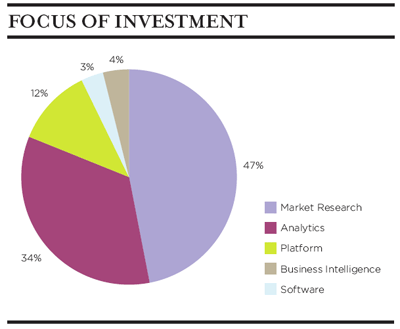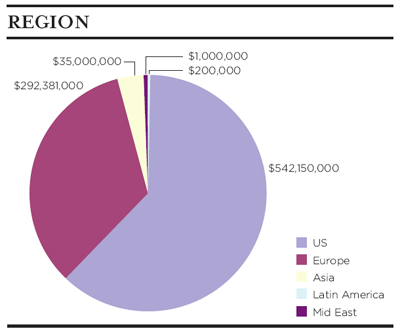Simon Chadwick
Results of the 2011 Cambiar Capital Funding Index
Looking to start up your next enterprise? Not sure how to attract funding? Here’s are a few clues: you should be based in the United States; your product should have something to do with social media; and the word “analytics” should appear liberally in your business plan. Or you should own a large French market research company (but more on that later).
These are the conclusions of the 2011 Cambiar Capital Funding Index, which studies how much funding flows into our (broad) industry over the course of a year, where it comes from, and whom it goes to.
From November 2010 to November 2011, a total of over US$870,000,000 in new capital was invested in market research, insights, intelligence and analytics companies. This was the total from all announced deals. An arbitrary (although reasonable) assumption is that this would comprise about 80% of all the capital infusion that actually took place, given that there are companies and investors out there who do not want their deals announced in the press or across the news feeds. If that is true, then the total amount of new capital inflows to the industry probably amounted to closer to US$1.1 billion in 2011. This is quite an impressive figure for an industry that ESOMAR, in its latest Global Report, estimates at around US$50 billion in annual revenues (this includes traditional market research, analytics, companies such as dunnhumby and Forrester and Gartner, and other market-knowledge related services).
At first sight, the amount of funding going into traditional market research, versus “newfangled” areas such as social media analytics, appears to be in proportion and relatively healthy. Similarly with the amount of funding originating in Europe versus the USA.
However, there is a major distortion in the data, resulting from the infusion of equity capital into IPSOS to assist in its acquisition of Synovate. The French giant raised Є200 million (the equivalent of US $270 million) in new capital on the Euronext Paris Bourse. If we exclude this major, one-off event, then the data become quite extreme:
- The US completely dominates the rest of the world as both a source of funding and home of the companies being funded by a factor of 10:1
- Investment in companies claiming “analytics” as their specialty outpaces investment in “market research” companies by a factor of 2.5:1
- Fully a third of all investment capital goes to firms that claim some sort of connection to social media
Focus of investment
Broadly speaking, investment capital flows into three types of ventures:
- Analytics companies (US$297 million)
- Market research (or related) companies (US$138 million)
- Companies dedicated to providing technology platforms for gathering, managing and analysing consumer and business information (US$101 million)
The word “analytics” would appear to cover a wide variety of applications, including web and text analytics as they apply to social media (by far the largest category); business intelligence analytics; analytics for websites and gaming sites; media analytics; shopper, purchaser and movement analytics … and on and on.
The question that must be asked here is whether this “analytics” boomlet represents a real and lasting trend, or is in fact a mini-bubble. Even allowing for the natural rate of failures in venture capital and private equity investments, those who have invested so heavily in all things analytic will still be looking for an overall rate of return of at least 4x on their investments. Back of the envelope calculations would suggest that those companies that actually do survive would have to be doing over US$600 million in revenues within the next four to five years. Although that seems initially to be a tall order, it is in fact quite doable if one or two breakout companies emerge from the throng. That will make a few investors very happy, but the majority will probably end up with less satisfying results.
If investors are showing great faith in analytics as the future, they are being quite choosy about where they put their dollars as far as market research is concerned. IPSOS aside, investors sunk only US$15 million into what we would regard as “traditional” full-service market research companies. Once again, research companies promising a focus on social media stood out from the rest, providing us with our second bubble opportunity (or at least buzzword). Of equal interest is where investors are placing their bets in terms of new research modalities – and where they are not:
Other areas of latent interest – perhaps signaling greater inflows in 2012 – are communities ($20 million) and digital marketing measurement (US$20 million).
The third overall bucket for investors is what we have categorised as “platforms.” These are companies whose primary role is to build the technologies on which data can be collected (in all forms), managed and analysed. These are the pure play technology entrants, but it must be said that the vast majority of companies receiving investment have some sort of technological component to them.
Region
It may be for this reason that the US so heavily dominates both investor and investee location. IPSOS aside, some US$600 million was invested in the industry in 2011. Of this, fully US$542 million happened inside the United States. For some time now, it has been clear that innovation in research in the US is very different from that in Europe and elsewhere. Whereas in Europe much of the innovation lies in new methodologies and heightened creativity in research, in America it is solidly founded in technology. Given Silicon Valley’s focus on technology, it is not surprising, therefore, to see such a concentration of capital investment happening in the US. Whereas the investment elsewhere might be characterised as being in IP, in the States it is in IT. The latter tends to be more expensive and therefore more in need of capital infusion.
Who is investing?
A round total of 100 different investment firms (and some individuals) were behind the US$600 million of seed, venture and private equity capital that flowed into the industry in 2011. Some of these were highly active, suggesting that our space is of special interest to them. Some of these are not surprising, including WPP’s venture arms, while others are clearly becoming major players in the future of our industry. These would include the Foundry Group, First Round Capital, Interwest, Draper Fisher Jurvetson, New Enterprise Associates and Sequoia Capital.
Two names that you might not have expected to see on this list are Andreesson Horowitz (a rock star entrepreneur and investor) and Bono (the rock star).
Now, if Bono thinks that our space is sexy, it really must be!
The Cambiar Capital Funding Index (CCFI) is compiled from public listings of new capital investments in the market research, intelligence and analytics industry. These are gathered from news feeds, press releases, public sites such as TechCrunch, and similar sources around the world. CCFI only takes into account new capital that enters the industry, and does not include mergers or acquisitions (unless new capital is injected as a result) or re-financings. For more information, please contact simon@consultcambiar.com.
Simon Chadwick is Managing Partner of Cambiar.






1 comment
[…] read with interest a recent summary on ESOMAR’s RW Connect of a report by Cambiar Consulting on 2011 capital funding in the market research […]